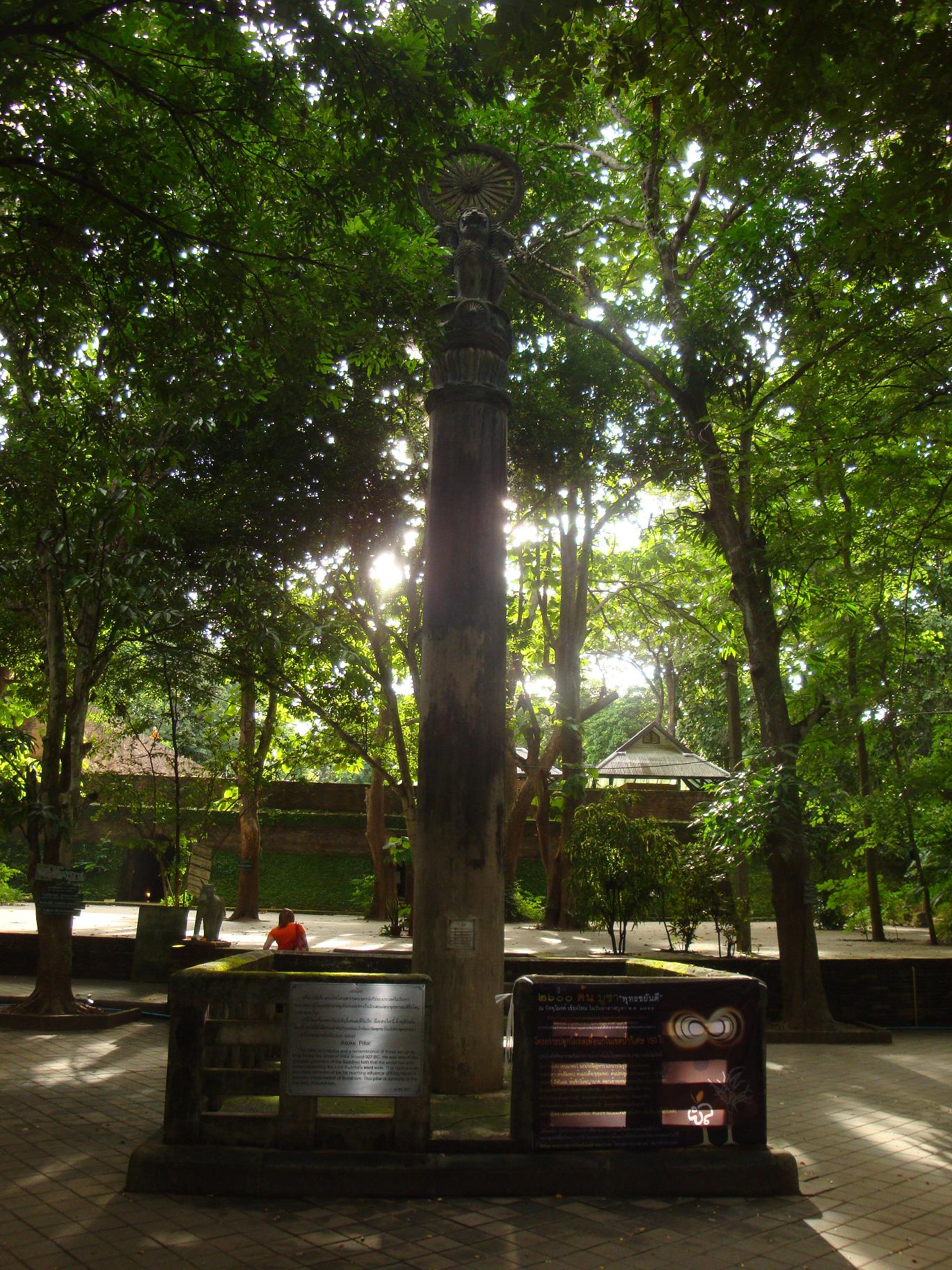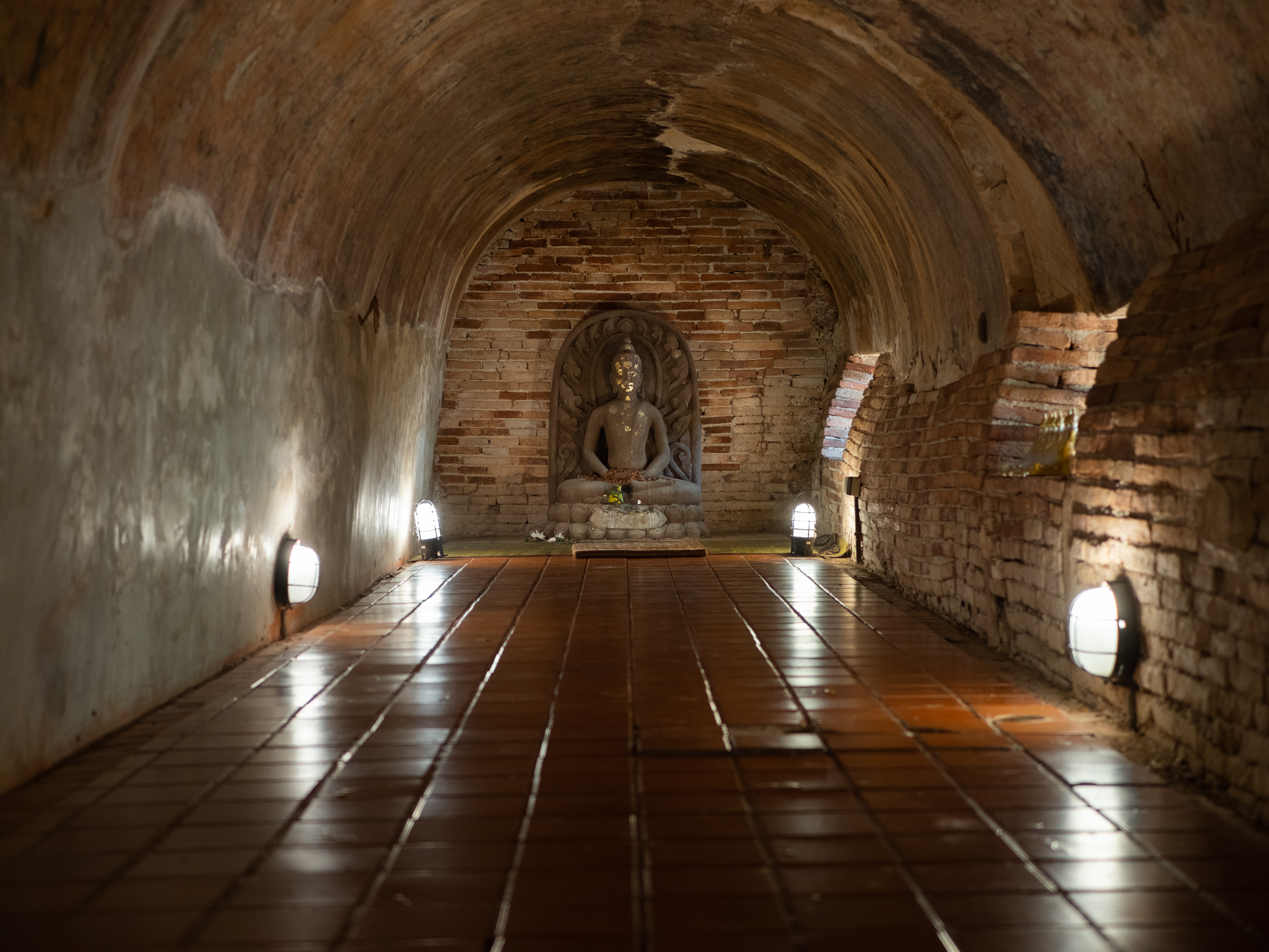Wat Umong on:
[Wikipedia]
[Google]
[Amazon]
Wat Umong (complete name: Wat Umong Suan Puthatham) is a 700-year-old
 The temple was built in 1297 by King Mangrai of the Lan Na dynasty.
Of particular interest is a modern replica of the original standing condition of the
The temple was built in 1297 by King Mangrai of the Lan Na dynasty.
Of particular interest is a modern replica of the original standing condition of the

 The entire Wat Umong complex consists of 37.5 rai (15 acres) of wooded grounds. You can feed the fish, turtles, and ducks in a large pond. "Talking trees" have words of wisdom in Thai and English. The wat is famous for its ancient tunnels and large chedi. There are tunnels with Buddhist images below the chedi which can be easily explored. These tunnels were supposedly built by the King and painted with bush scenes so they could keep a famous but mentally deranged monk within the grounds of the monastery as he had a habit of just wandering off into the bush for days on end. Signs (proverbs) written in English and Thai hang from the trees on footpaths leading to the small lake where fish, pigeons, and turtles can be fed.
Other attractions include a Buddha field of broken sculpture, a fasting Bodhisattva, a Spiritual Theatre of paintings similar to those at Suan Mokkh, reproductions of ancient Buddhist sculpture of India, and a library-museum. This last building offers many books on Buddhism and other philosophies as well as a collection of historic objects and Buddhist art.
The entire Wat Umong complex consists of 37.5 rai (15 acres) of wooded grounds. You can feed the fish, turtles, and ducks in a large pond. "Talking trees" have words of wisdom in Thai and English. The wat is famous for its ancient tunnels and large chedi. There are tunnels with Buddhist images below the chedi which can be easily explored. These tunnels were supposedly built by the King and painted with bush scenes so they could keep a famous but mentally deranged monk within the grounds of the monastery as he had a habit of just wandering off into the bush for days on end. Signs (proverbs) written in English and Thai hang from the trees on footpaths leading to the small lake where fish, pigeons, and turtles can be fed.
Other attractions include a Buddha field of broken sculpture, a fasting Bodhisattva, a Spiritual Theatre of paintings similar to those at Suan Mokkh, reproductions of ancient Buddhist sculpture of India, and a library-museum. This last building offers many books on Buddhism and other philosophies as well as a collection of historic objects and Buddhist art.
Information about meditation and learning on the temple's website
/ref>
Own website of Wat Umong
{{coord, 18, 46, 59.46, N, 98, 57, 4.71, E, display=title, type:landmark Umong 13th century in Chiang Mai
Buddhist
Buddhism ( , ), also known as Buddha Dharma and Dharmavinaya (), is an Indian religion or philosophical tradition based on teachings attributed to the Buddha. It originated in northern India as a -movement in the 5th century BCE, and ...
temple
A temple (from the Latin ) is a building reserved for spiritual rituals and activities such as prayer and sacrifice. Religions which erect temples include Christianity (whose temples are typically called churches), Hinduism (whose temples ...
in Chiang Mai, Thailand
Thailand ( ), historically known as Siam () and officially the Kingdom of Thailand, is a country in Southeast Asia, located at the centre of the Indochinese Peninsula, spanning , with a population of almost 70 million. The country is b ...
.
It should not be confused with the temple with a similar name within the old city moat of Chiang Mai, whose complete name is "Wat Umong Maha Thera Chan".
Location
Wat Umong is located against the mountains ofDoi Suthep
Doi Suthep (ดอยสุเทพ), is a mountain ("doi") west of Chiang Mai, Thailand. It is in elevation and is one of the twin peaks of a granite mountain. The other peak is known as Doi Pui and is slightly higher ().
Doi Suthep is from ...
and is about 1 km south of the main campus of Chiang Mai University
Chiang Mai University ( CMU; th, มหาวิทยาลัยเชียงใหม่) is a public research university in northern Thailand founded in 1964. It has a strong emphasis on engineering, science, agriculture, and medicine. It ...
. The wat occupies a tranquil setting and a small open zoo is stationed behind it.
History
 The temple was built in 1297 by King Mangrai of the Lan Na dynasty.
Of particular interest is a modern replica of the original standing condition of the
The temple was built in 1297 by King Mangrai of the Lan Na dynasty.
Of particular interest is a modern replica of the original standing condition of the pillar of Ashoka
The pillars of Ashoka are a series of monolithic columns dispersed throughout the Indian subcontinent, erected or at least inscribed with edicts by the Mauryan Emperor Ashoka during his reign from c. 268 to 232 BCE. Ashoka used the expressi ...
at Sarnath
Sarnath (Hindustani pronunciation: aːɾnaːtʰ also referred to as Sarangnath, Isipatana, Rishipattana, Migadaya, or Mrigadava) is a place located northeast of Varanasi, near the confluence of the Ganges and the Varuna rivers in Uttar Pr ...
in India. The Lion Capital of Ashoka
The Lion Capital of Ashoka is the capital, or head, of a column erected by the Mauryan emperor Ashoka in Sarnath, India, . Its crowning features are four life-sized lions set back to back on a drum-shaped abacus. The side of the abacus ...
survives in the Sarnath Museum
Sarnath Museum is the oldest site museum of Archaeological Survey of India. It houses the findings and excavations at the archaeological site of Sarnath, by the Archaeological Survey of India. Sarnath is located near Varanasi, in the state of Ut ...
, in an incomplete state, and at Indian independence was adopted as the National Emblem of India
The State Emblem of India is the national emblem of the Republic of India and is used by the union government, many state governments, and other government agencies. The emblem is an adaptation of the Lion Capital of Ashoka, an ancient sculp ...
. It consists in four lions standing on an abacus, crowned by a large wheel called a ''Dharmachakra
The dharmachakra (Sanskrit: धर्मचक्र; Pali: ''dhammacakka'') or wheel of dharma is a widespread symbol used in Indian religions such as Hinduism, Jainism, and especially Buddhism.John C. Huntington, Dina Bangdel, ''The Circle o ...
''.
Structure and layout

 The entire Wat Umong complex consists of 37.5 rai (15 acres) of wooded grounds. You can feed the fish, turtles, and ducks in a large pond. "Talking trees" have words of wisdom in Thai and English. The wat is famous for its ancient tunnels and large chedi. There are tunnels with Buddhist images below the chedi which can be easily explored. These tunnels were supposedly built by the King and painted with bush scenes so they could keep a famous but mentally deranged monk within the grounds of the monastery as he had a habit of just wandering off into the bush for days on end. Signs (proverbs) written in English and Thai hang from the trees on footpaths leading to the small lake where fish, pigeons, and turtles can be fed.
Other attractions include a Buddha field of broken sculpture, a fasting Bodhisattva, a Spiritual Theatre of paintings similar to those at Suan Mokkh, reproductions of ancient Buddhist sculpture of India, and a library-museum. This last building offers many books on Buddhism and other philosophies as well as a collection of historic objects and Buddhist art.
The entire Wat Umong complex consists of 37.5 rai (15 acres) of wooded grounds. You can feed the fish, turtles, and ducks in a large pond. "Talking trees" have words of wisdom in Thai and English. The wat is famous for its ancient tunnels and large chedi. There are tunnels with Buddhist images below the chedi which can be easily explored. These tunnels were supposedly built by the King and painted with bush scenes so they could keep a famous but mentally deranged monk within the grounds of the monastery as he had a habit of just wandering off into the bush for days on end. Signs (proverbs) written in English and Thai hang from the trees on footpaths leading to the small lake where fish, pigeons, and turtles can be fed.
Other attractions include a Buddha field of broken sculpture, a fasting Bodhisattva, a Spiritual Theatre of paintings similar to those at Suan Mokkh, reproductions of ancient Buddhist sculpture of India, and a library-museum. This last building offers many books on Buddhism and other philosophies as well as a collection of historic objects and Buddhist art.
Current status
Wat Umong is unique in that the resident monks live in a very natural setting, and occasionally feed the deer that live in the area. It also is possible to practice meditation at Wat Umong and to learn from the monks./ref>
References
External links
Own website of Wat Umong
{{coord, 18, 46, 59.46, N, 98, 57, 4.71, E, display=title, type:landmark Umong 13th century in Chiang Mai